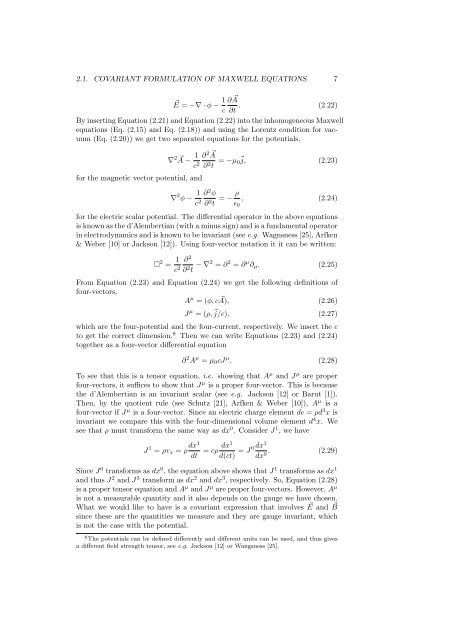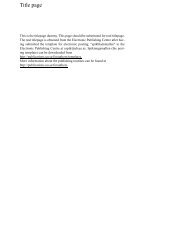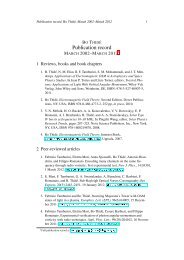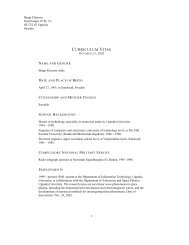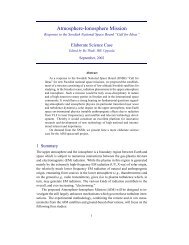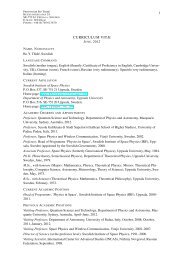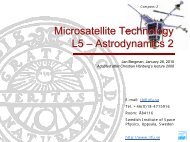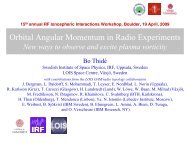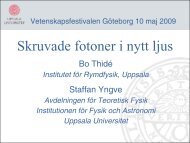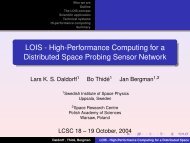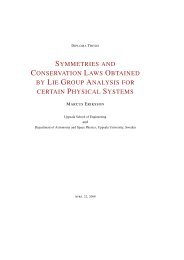Towards a covariant formulation of electromagnetic wave polarization
Towards a covariant formulation of electromagnetic wave polarization
Towards a covariant formulation of electromagnetic wave polarization
Create successful ePaper yourself
Turn your PDF publications into a flip-book with our unique Google optimized e-Paper software.
2.1. COVARIANT FORMULATION OF MAXWELL EQUATIONS 7<br />
⃗E = −∇ · φ − 1 ∂A<br />
⃗<br />
c ∂t . (2.22)<br />
By inserting Equation (2.21) and Equation (2.22) into the inhomogeneous Maxwell<br />
equations (Eq. (2.15) and Eq. (2.18)) and using the Lorentz condition for vacuum<br />
(Eq. (2.20)) we get two separated equations for the potentials,<br />
for the magnetic vector potential, and<br />
∇ 2 ⃗ A −<br />
1<br />
c 2 ∂ 2 ⃗ A<br />
∂ 2 t = −µ 0 ⃗ j, (2.23)<br />
∇ 2 φ − 1 c 2 ∂ 2 φ<br />
∂ 2 t = − ρ ɛ 0<br />
, (2.24)<br />
for the electric scalar potential. The differential operator in the above equations<br />
is known as the d’Alembertian (with a minus sign) and is a fundamental operator<br />
in electrodynamics and is known to be invariant (see e.g. Wagnsness [25], Arfken<br />
& Weber [10] or Jackson [12]). Using four-vector notation it it can be written:<br />
□ 2 = 1 c 2 ∂ 2<br />
∂ 2 t − ∇2 = ∂ 2 = ∂ µ ∂ µ . (2.25)<br />
From Equation (2.23) and Equation (2.24) we get the following definitions <strong>of</strong><br />
four-vectors,<br />
A µ = (φ, c ⃗ A), (2.26)<br />
J µ = (ρ,⃗j/c), (2.27)<br />
which are the four-potential and the four-current, respectively. We insert the c<br />
to get the correct dimension. 8 Then we can write Equations (2.23) and (2.24)<br />
together as a four-vector differential equation<br />
∂ 2 A µ = µ 0 cJ µ . (2.28)<br />
To see that this is a tensor equation, i.e. showing that A µ and J µ are proper<br />
four-vectors, it suffices to show that J µ is a proper four-vector. This is because<br />
the d’Alembertian is an invariant scalar (see e.g. Jackson [12] or Barut [1]).<br />
Then, by the quotient rule (see Schutz [21], Arfken & Weber [10]), A µ is a<br />
four-vector if J µ is a four-vector. Since an electric charge element de = ρd 3 x is<br />
invariant we compare this with the four-dimensional volume element d 4 x. We<br />
see that ρ must transform the same way as dx 0 . Consider J 1 , we have<br />
J 1 = ρv x = ρ dx1<br />
dt<br />
= cρ dx1<br />
d(ct) = J 0 dx1<br />
dx 0 . (2.29)<br />
Since J 0 transforms as dx 0 , the equation above shows that J 1 transforms as dx 1<br />
and thus J 2 and J 3 transform as dx 2 and dx 3 , respectively. So, Equation (2.28)<br />
is a proper tensor equation and A µ and J µ are proper four-vectors. However, A µ<br />
is not a measurable quantity and it also depends on the gauge we have chosen.<br />
What we would like to have is a <strong>covariant</strong> expression that involves ⃗ E and ⃗ B<br />
since these are the quantities we measure and they are gauge invariant, which<br />
is not the case with the potential.<br />
8 The potentials can be defined differently and different units can be used, and thus gives<br />
a different field strength tensor, see e.g. Jackson [12] or Wangsness [25].


